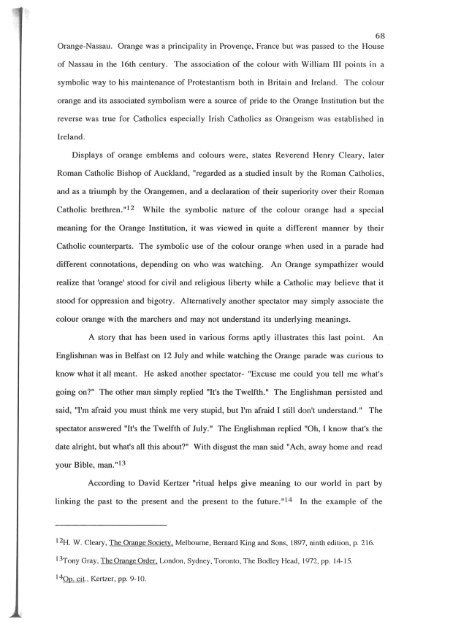TRANSPLANTED IRISH INSTITUTIONS - University of Canterbury
TRANSPLANTED IRISH INSTITUTIONS - University of Canterbury
TRANSPLANTED IRISH INSTITUTIONS - University of Canterbury
Create successful ePaper yourself
Turn your PDF publications into a flip-book with our unique Google optimized e-Paper software.
68<br />
Orange-Nassau. Orange was a principality in Proven~, France but was passed to the House<br />
<strong>of</strong> Nassau in the 16th century. The association <strong>of</strong> the colour with William III points in a<br />
symbolic way to his maintenance <strong>of</strong> Protestantism both in Britain and Ireland. The colour<br />
orange and its associated symbolism were a source <strong>of</strong> pride to the Orange Institution but the<br />
reverse was true for Catholics especially Irish Catholics as Orangeism was established In<br />
Ireland.<br />
Displays <strong>of</strong> orange emblems and colours were, states Reverend Henry Cleary, later<br />
Roman Catholic Bishop <strong>of</strong> Auckland, "regarded as a studied insult by the Roman Catholics,<br />
and as a triumph by the Orangemen, and a declaration <strong>of</strong> their superiority over their Roman<br />
Catholic brethren. "12<br />
While the symbolic nature <strong>of</strong> the colour orange had a special<br />
meaning for the Orange Institution, it was viewed in quite a different manner by their<br />
Catholic counterparts. The symbolic use <strong>of</strong> the colour orange when used in a parade had<br />
different connotations, depending on who was watching. An Orange sympathizer would<br />
realize that 'orange' stood for civil and religious liberty while a Catholic may believe that it<br />
stood for oppression and bigotry. Alternatively another spectator may simply associate the<br />
colour orange with the marchers and may not understand its underlying meanings.<br />
A story that has been used in various forms aptly illustrates this last point. An<br />
Englishman was in Belfast on 12 July and while watching the Orange parade was curious to<br />
know what it all meant. He asked another spectator- "Excuse me could you tell me what's<br />
going on?" The other man simply replied "It's the Twelfth." The Englishman persisted and<br />
said, "I'm afraid you must think me very stupid, but I'm afraid I still don't understand." The<br />
spectator answered "It's the Twelfth <strong>of</strong> July." The Englishman replied "Oh, I know that's the<br />
date alright, but what's all this about?" With disgust the man said "Ach, away home and read<br />
your Bible, man."13<br />
According to David Kertzer "ritual helps give meaning to our world in part by<br />
linking the past to the present and the present to the future." 14<br />
In the example <strong>of</strong> the<br />
12H. W. Cleary, The Orange Society. Melbourne, Bernard King and Sons, 1897. ninth edition, p. 216.<br />
13Tony Gray, The Orange Order, London, Sydney, Toronto, The Bodley Head, 1972, pp. 14-15.<br />
140p. ci t. , Kertzer, pp. 9- 10.
















